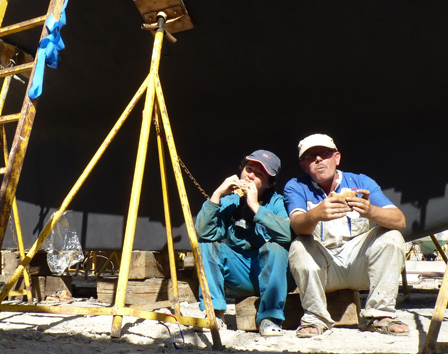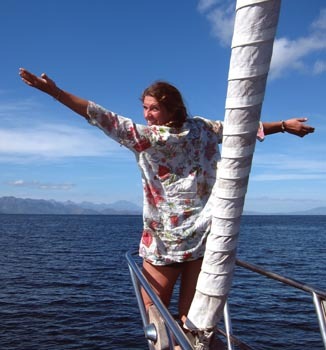Rick Page's Blog, page 4
March 26, 2016
Apocalypso
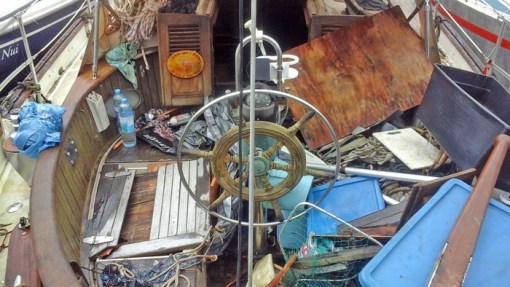 In June last year, we were offered a job skippering a $2m dollar yacht from Bora Bora to Fiji. The money wasn’t great, but the owners were friends of ours, so we decided it would be a nice experience (it wasn’t, but more on that in another post). So, armed with our charts (apparently $2m dollar yachts don’t need them) and a big dollop of optimism, we put Calypso to bed in a small yacht club in Port Phaeton, Tahiti and jumped on a plane for the short hop to Bora Bora.
In June last year, we were offered a job skippering a $2m dollar yacht from Bora Bora to Fiji. The money wasn’t great, but the owners were friends of ours, so we decided it would be a nice experience (it wasn’t, but more on that in another post). So, armed with our charts (apparently $2m dollar yachts don’t need them) and a big dollop of optimism, we put Calypso to bed in a small yacht club in Port Phaeton, Tahiti and jumped on a plane for the short hop to Bora Bora.
Several months later, having delivered that posh yacht to Fiji, toured around NZ in a van and visited Europe on a book promotion tour, we returned to find our boat in an extremely sorry state. The guy who was meant to be looking after, well, wasn’t.
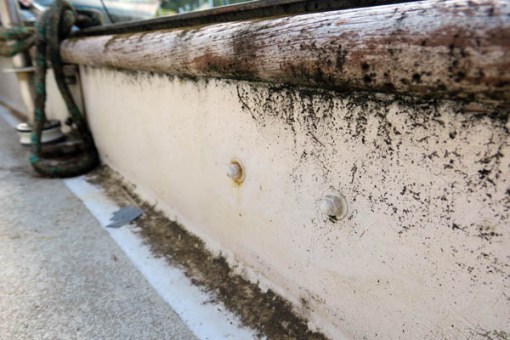 Port Phaeton is very wet in the monsoon season and it is important to keep the watery stuff on the outside of the boat. The guy looking after our boat had not done that. Instead, he had managed to put his foot through the cockpit locker and (for reasons best known to himself) not bothered to cover up the hole, despite there being all kinds of boards and tarps within spitting distance. Furthermore, the cockpit drains were blocked with leaf debris (and plastic wrappers for the de-humidifier crystals that our boat ‘carer’ was still replacing despite the boat being flooded out) which meant the cockpit was filling with water which was pouring over the bridge deck into the companionway as well as into the boat via the busted cockpit locker.
Port Phaeton is very wet in the monsoon season and it is important to keep the watery stuff on the outside of the boat. The guy looking after our boat had not done that. Instead, he had managed to put his foot through the cockpit locker and (for reasons best known to himself) not bothered to cover up the hole, despite there being all kinds of boards and tarps within spitting distance. Furthermore, the cockpit drains were blocked with leaf debris (and plastic wrappers for the de-humidifier crystals that our boat ‘carer’ was still replacing despite the boat being flooded out) which meant the cockpit was filling with water which was pouring over the bridge deck into the companionway as well as into the boat via the busted cockpit locker.
This flooded out the batteries, which stopped the automatic bilge pump and things just kept getting worse. In short this is what we came back to.
Boat flooded out with over a meter of oily bilge water
No Electrics
No Batteries
Black mold everywere
Much laquer destroyed
Mushrooms growing from the instruments
Very rusty engine where it had been sitting in water (new coupling destroyed)
Busted instruments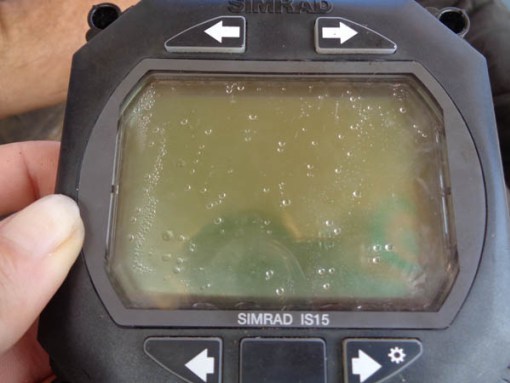
Busted radar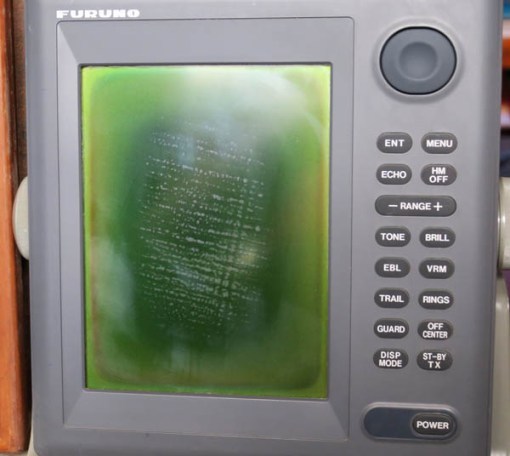
Busted outboard
Floorboards rotten and swollen
Much wiring destroyed
Cockpit locker lid destroyed
Green decks
Fridge compressor (which lived in the cockpit locker) completely rusted out and various personal possession damaged (including my bloody saxophone).
A certain amount of swearing was also present.
When I first arrived, I did not have the heart to take photos so, these are how the boat looked a week later – still pretty bad.
Anyway, that was about a month ago. Since then, Jasna and I have been cleaning, scrubbing, repairing, mechanicking, epoxying, sanding, wiring, servicing, shopping – and then doing it all over again, to return Calypso to her former glory (which is partly why we have been a bit slack on our posting).
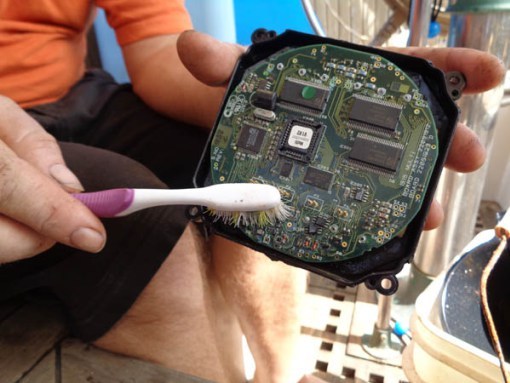 Buckets of sweat and all the money we made (and then some) from the delivery later, and we are nearly back to normal. At the very least, the light at the end of the tunnel does not appear to be an oncoming train.
Buckets of sweat and all the money we made (and then some) from the delivery later, and we are nearly back to normal. At the very least, the light at the end of the tunnel does not appear to be an oncoming train.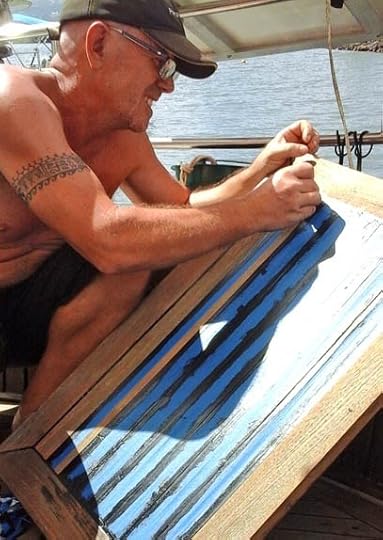
In a week or two, we will be ready to hit the high sea again and continue our adventures. Despite the disaster, it is good to be home.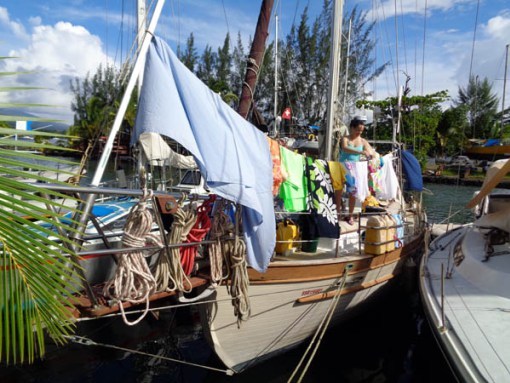
November 29, 2015
Polynesian Tattoos

 The Tattoo has always been an important part of Polynesian culture.
The Tattoo has always been an important part of Polynesian culture.
As early as 1767, Captain Samuel Wallis noticed that it was;
“a universal custom among men and women to get their buttocks and the back of their thighs painted with thin black lines representing different figures”.
The word ‘tattoo’ was first used by Captain Cook. It is the phonetic transcription of the Polynesian word ‘tatau’, which means ‘to hit’. Back then, the tattoo artist used tapered animal bones or teeth, which they would tap the backs of to drive the ink under the skin.
Modern Polynesian tattoo artists may have broken that tradition (they now use an electric needle) but the designs remain steeped in tradition – each with their very own distinct meaning.
While the main purpose of tattooing is decoration, the various designs also tell specific stories or denote affiliation with certain groups. Many Polynesians also believe that tattoos can protect them from evil.
Tattooing experienced a crisis when the missionaries brought Catholicism to the islands. Suddenly the naked body had to be covered, rendering the tattoos somewhat pointless.
Today, Polynesians, having largely shed the repressive yoke of Catholicism, have re-embraced this wonderfully creative aspect of their cultural heritage.
This is particularly true in the Marquesas where it is almost impossible to find an adult Marquesan without a tattoo. Men are often tattooed on the arms, back and chest while the women tend to opt for neck, lower back and legs. The Marquesan islands of Tahuata, Hiva Oa and Nuku Hiva are home to some of the best tattoo artist in Polynesia.



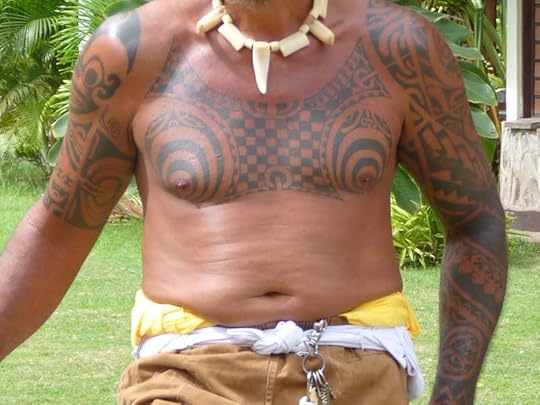




As sailors and visitors to this land, we tend at first to simply watch and admire the wonderful array of inked bodies. However, after a while one starts to feel naked. When that happens, tattoo fever is never far behind. 
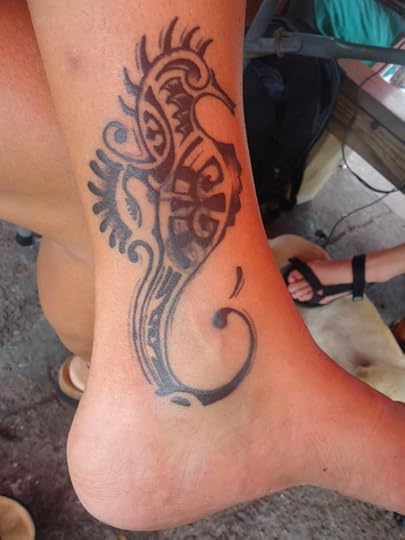
So which one of us got the fever?
The answer is we both did!
Rick picked a strip of typical Polynesian symbols that represents his travels across the Pacific
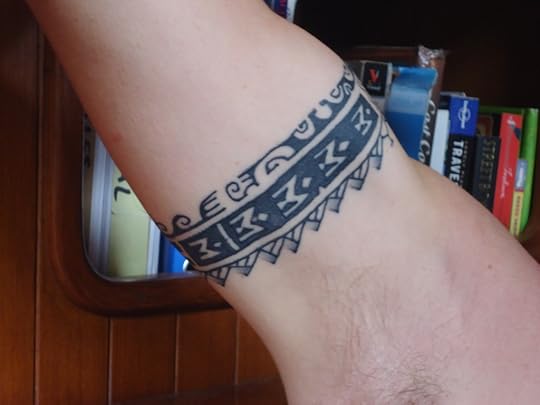
Jasna told the artist (Moana Junior from Taiohae) that she loves sailing and diving. She ended up with a half fish – half boat design.
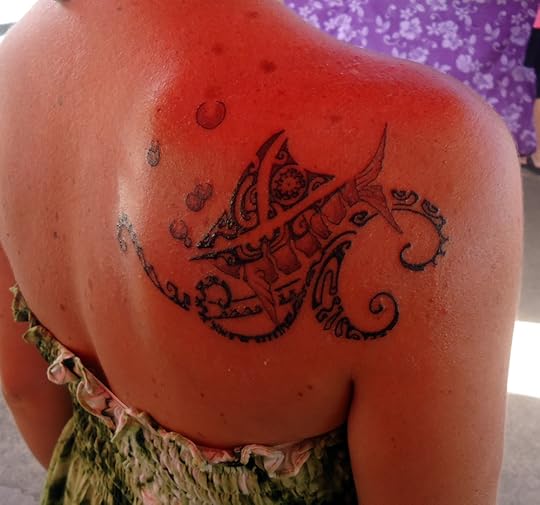
And so we are not naked anymore.
These will be our permanent souvenirs of the special people of the Marquesas islands which hosted us for seven unforgettable months.

September 30, 2015
Beach umbrella for cruisers
Yo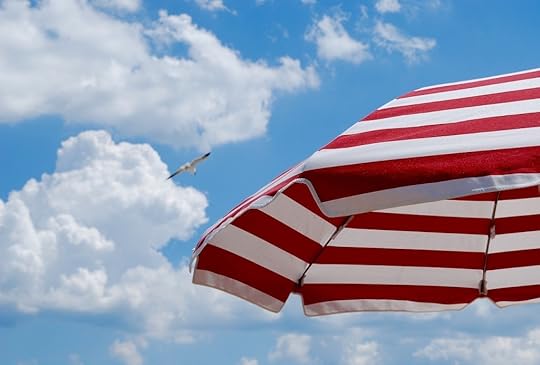 u’ve probably never thought of including a beach umbrella on the list of desirable safety gear for your boat.
u’ve probably never thought of including a beach umbrella on the list of desirable safety gear for your boat.
But you should, especially if you are sailing towards remote locations.
There is two very good reasons for that.
The first one is the obvious one.
Sometimes you will stop at tropical islands where you can lie in the shade of a palm tree.
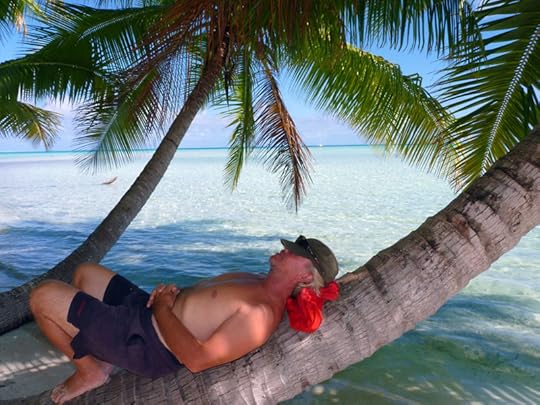
Rick at work in Fakarava, French Polynesia
But many other times, you will visit islands with no vegetation at all.
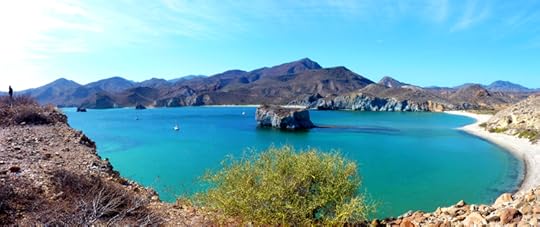
Caleta san Juanico in the Sea of Cortez, Mexico
If you are planning to lay on the beach for more than 2 hours, you need some kind of shade to protect your skin from the tropical sun. With no trees, you need a beach umbrella.
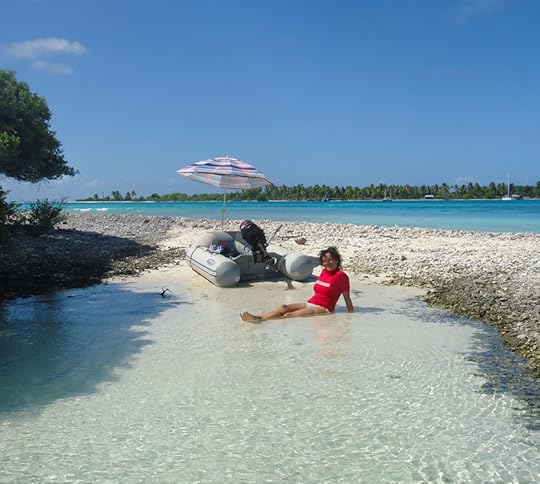
Beach day in Toau, Tuamotu Archipelago
Or maybe you fancy lying in the hammock but you also don’t want to get cooked by the sun.
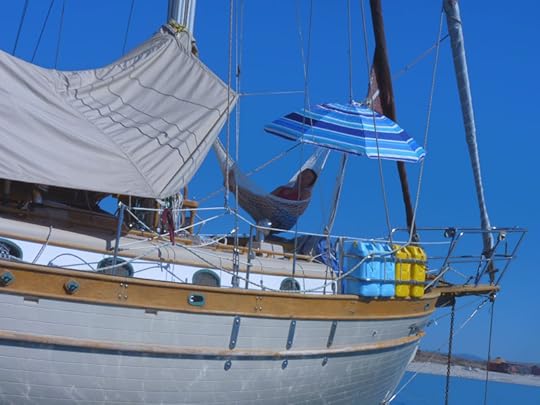
But the main reason we recommend having an umbrella on your cruising boat is that it can help you staying sane.
As we all know too well, cruising also means fixing things at anchor.
Imagine you are trying to reassemble your furling system after you finished servicing it. There is only one nut to go and you are already looking forward to that big margarita you deserve for a job well done.
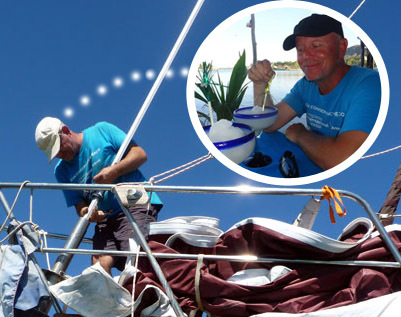 You fiddle with your fingers and just as you thought that the nut grabbed the tread…
You fiddle with your fingers and just as you thought that the nut grabbed the tread…
…plonk!
Noooooo!!! The big unique nut fell in the water!
No margarita for you, I am afraid.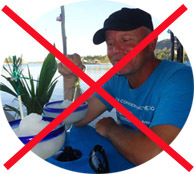
Instead you win a very frustrating day of walking around dusty streets in search of a miracle or maybe a long night of internet research to try and find someone who can ship a replacement part to the middle of the Pacific for less than 100$ in less than a month.
I am sure this happened to anyone who has been cruising for some time. Whether you are working on the rigging or on the outboard, there is the risk of losing something in the drink.
But there is no need for all this frustration, the solution is simple.
You need an umbrella!
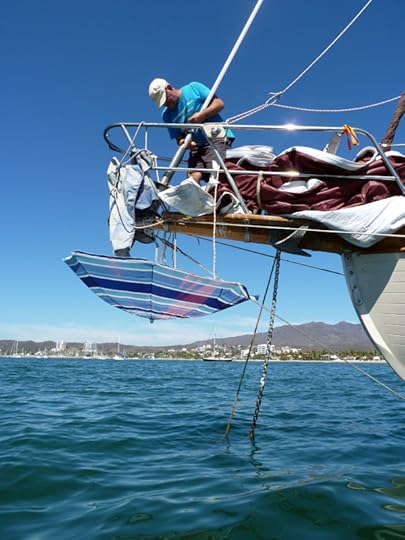
We bought this one in Mexico for about 3$ and this is what we achieved:
Many more beach days and no sunburns.
No more nervous breakdowns during deck projects.
Every time a bolt or a screw falls in it, we feel so pleased with ourselves, we decide we deserve a double margarita!
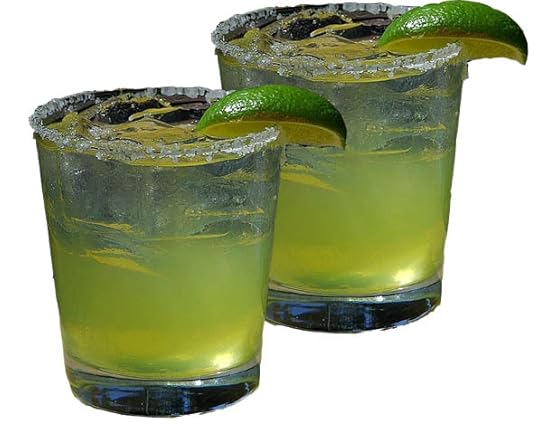
September 17, 2015
Paradise WiFi: 5 Cheapest Internet Cafes In French Polynesia
Communication with the outside world can often be a problem in French Polynesia.
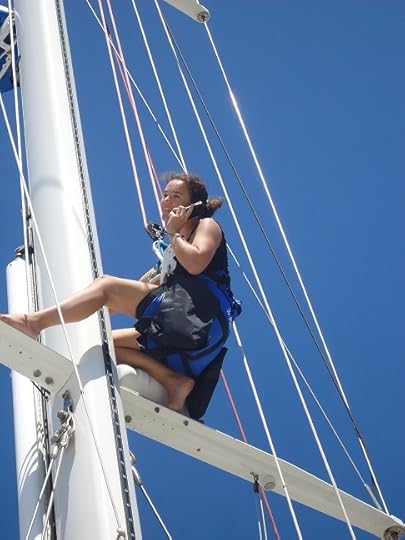
The phone coverage is very poor on most islands and the internet connection is even worse. Prepaid internet is very expensive – too expensive for us. That’s why we appreciate so much these 5 places where you can get internet almost for free.
1. SNACK VAEKI, best known as CHEZ HENRI (Henri’s place) – Nuku Hiva
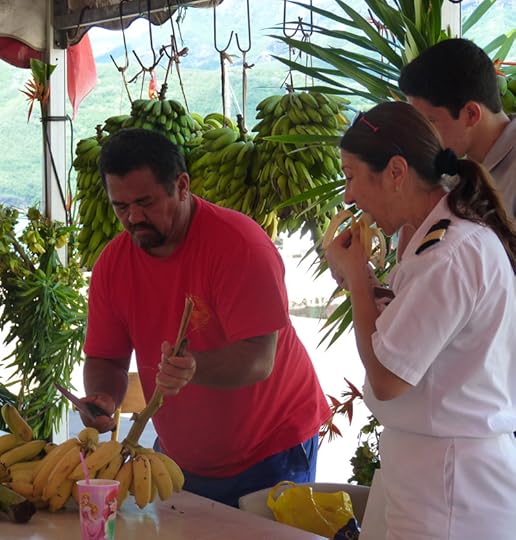 Henri is a legend. At his place you can type away your emails while a group of locals sing lovely Polynesian tunes accompanied by ukuleles and the chickens peck your feet. When you get hungry, you get up, pick a banana or two from the stash hanging all around you. This is a meeting point for all the cruisers arriving across the Pacific and in the high season is always packed with cruisers. That’s why the internet can be quite slow. If you need a better connection for downloading or to call your mum on Skype, you have to go there at 5 am. You will be surprised to find Chez Henri already full of locals eating fish for breakfast.
Henri is a legend. At his place you can type away your emails while a group of locals sing lovely Polynesian tunes accompanied by ukuleles and the chickens peck your feet. When you get hungry, you get up, pick a banana or two from the stash hanging all around you. This is a meeting point for all the cruisers arriving across the Pacific and in the high season is always packed with cruisers. That’s why the internet can be quite slow. If you need a better connection for downloading or to call your mum on Skype, you have to go there at 5 am. You will be surprised to find Chez Henri already full of locals eating fish for breakfast.
Sooner or later, you will end op at Henri’s place and when you do, make sure you order a fresh mango juice. They are unbeatable and Henri doesn’t mind if you put your own tot of rum in it as he doesn’t have a licence for alcohol.
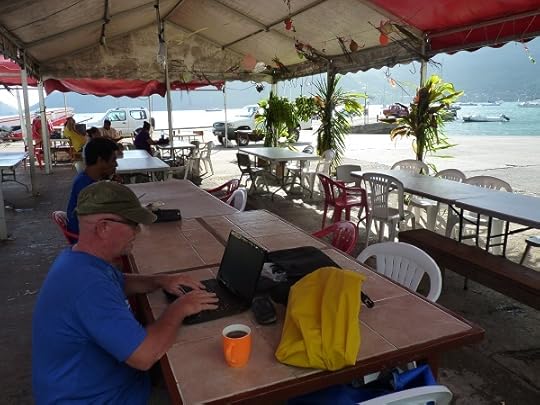
Snack Vaeki, Taiohae, Nuku Hiva
2. FAKARAVA YACHT SERVICES
 Aldric and Stephanie are ex-cruisers who moved to this little piece of paradise and started a business dedicated to cruisers. They offer free internet connection if you buy a coffee or a juice, but they also rent bikes and take care of your laundry. If you need anything else, just ask. Their couch is very comfortable and their espresso the best in Polynesia, no question.
Aldric and Stephanie are ex-cruisers who moved to this little piece of paradise and started a business dedicated to cruisers. They offer free internet connection if you buy a coffee or a juice, but they also rent bikes and take care of your laundry. If you need anything else, just ask. Their couch is very comfortable and their espresso the best in Polynesia, no question.
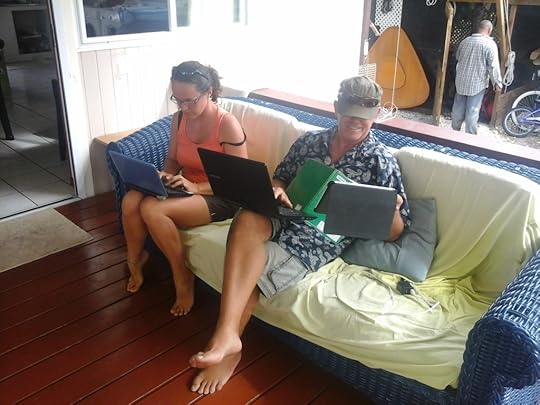
Fakarava Yacht Services
3. VAITAHU under the pamplemousse tree by the only shop in town
Vaitahu on the island of Tahuata is a very lovely town, well worth a visit. In town you will find a beautiful church, a museum, a post office, lots of nice locals and a little shop/bakery. This is also a wi-fi spot and there is a nice table where you can sit in the shade of a big tree. If you buy something from the shop you can ask for the password, but don’t expect a fast connection! What you can expect is a big smile and helpful attitude from the French guy who owns the store.
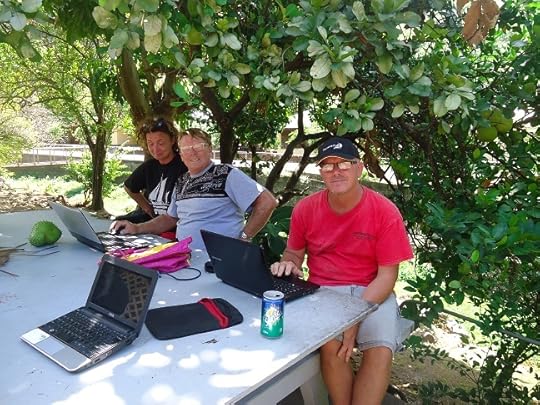
Vaitahu, Tahuata, Marquesas
4. ATUONA, HIVA OA (only off season)
Sandra runs Hiva Oa Yacht Services and offers internet connection inside/in front of/behind her office. The price is quite high in season (April to August), but in the low season drops to almost nothing. With the Alfa we managed to get her internet aboard as well, but only because we were anchored very close by. In the high season, the internet cafe in town is a cheaper choice and they make great pancakes too!
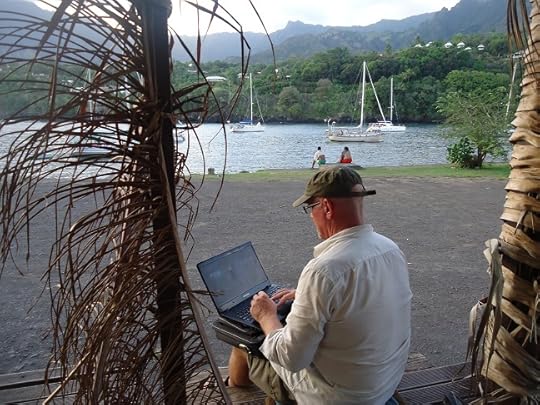
Atuona, Hiva Oa, Marquesas
5. CARREFOUR TARAVAO, TAHITI
The only place we found in Tahiti where the internet was fast and free was in the big Carrefour in Taravao (between Tahiti Iti and Tahiti Nui). They have tables with chairs and very fast internet. You can buy a drink or a snack but it is not compulsory.
I am sure there are many more “secret” spots and if you know of any, please let us know, so we can add them to our list.
p.s. I was not sure if writing this post was a really good idea… secret spots are usually great only until they are discovered. But to be fair, the amount of yachts that go through these spots every year is so small, I hardly can see them getting too crowded…
September 13, 2015
Do I need health insurance?
This is a question that often seems strange to us Europeans who have grown up in societies with advanced social health programmes, but is a very real cause for concern for Americans who are thinking of sailing off into the horizon.
Imagine you have grown up in a country where the government taxes vegetables 1000% – where a carrot costs $10 and a veggie stir-fry could easily run to $100. On top of that imagine if that same government and media also managed to convince you that vegetables elsewhere in the world were sub-standard and even dangerous to consume. What do you imagine would be the first question you asked people who left your country and traveled abroad to live on a boat? Probably something like “how do you eat?”, “where do you get your vegetables?”” How do you afford to live?” or something like that.
I mention this because we (along with many European sailors) are often perplexed by, and sometimes a little dismissive of, the attention our American cousins seem to focus on the subject of health insurance. For those that don’t understand why this is, under no circumstances should you get sick in the US.
US citizens have been so grossly overcharged for so long for health care that they have come to accept it as normal. Furthermore, the American medical machine tries to justify this by claiming to be (contrary to the figures) far superior to anywhere else. Years of this propaganda have had their effect – many American sailors we meet have policies that involve immediate repatriation to the US should they become ill, which suggests that at least some have bought the idea that health care outside the US is sub-standard or even dangerous.
The good news is that health care around the world is a lot better than many have been lead to believe, often better than the US and much better than any of our parents had anywhere.
In my 20+ years of being on the move, I have been treated in Kenya (malaria), Uganda (dengue fever) Malawi (wisdom teeth), Zimbabwe (facial and rib trauma), UK (head trauma and dengue), Spain (leg trauma), Mexico (kidney infection), and now Fiji (dentistry). Some of these treatments required several days in a hospital bed – others over a week.
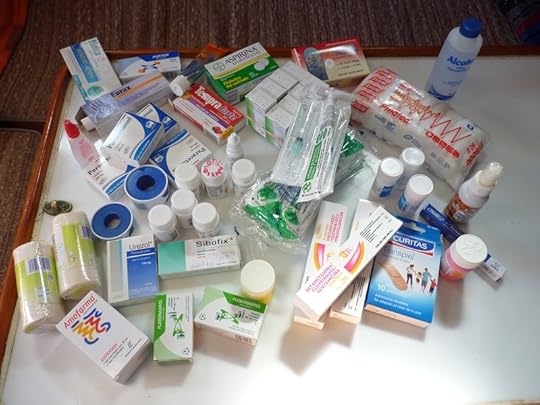
Self treatment can cure most minor things and is very economical. Our entire drug cabinet pictured here cost less than $50 and was available on prescription once we paid for a doctor’s consultation to help define our on board needs. The consultation and prescription cost $4
All the treatments I have received have been exemplary. I paid cash for all of them and added up together they come to less than $1500. In the same period, the average American would have spent at least $69,000 in premiums (or just shy of $175,000 for a family policy).
When my (then) girlfriend fell down the stairs at Flagler beach (Florida) and chipped a bone, the bill came $16,000 and the service was no better than anywhere else in the world. When I did more or less the same thing in Spain, the bill was just over 100 Euros. Most sea gypsies we have met will relate similar experiences.
Jasna and I are both confessed Americanphiles. With the obvious exception of Sarah Palin or that Trump bloke with the wig, we always hit it off with the Yanks and it seems a shame that the fear of getting sick or injured whilst uninsured and abroad seems to be holding so many of them back from joining us out here on the big blue.
Sailing is a healthy lifestyle and your health will improve immeasurably just by eating well, living with less stress and not driving every day. So if the fear of not being insured is stopping you realising your dream, worry not. If you can shut out the voices of the ‘what if’ brigade and stop wondering why nobody else is paying $10 for a carrot, you will be a lot closer to reality, health and happiness than the fantastically over-insured, over fed and over stressed.
September 5, 2015
Homemade fruit bars
 As I already mentioned several times, the biggest problem cruisers have in the Marquesas islands is how to eat all the bananas they have aboard before they go bad. I already wrote a post with many recipes which you can find here.
As I already mentioned several times, the biggest problem cruisers have in the Marquesas islands is how to eat all the bananas they have aboard before they go bad. I already wrote a post with many recipes which you can find here.
Since then I found a new excellent use which I am going to share with you. The idea is not mine, I found it in the great book Sailing The Farm.
I will show you how to make your own fruit bars.
I love making them and Rick loves eating them on long passages (if I hide them very well, otherwise they disappear in the first day…).
But before I explain the process, let me give you 6 reasons why you should make your own fruit bars instead of buying them.
you can make them EXACTLY the way you like them, with or without nuts, chocolate chips, seeds, etc.
they are much fresher and therefore healthier
they have no sugar (you may find organic sugarless bars in London or San Diego, but not in the Pacific islands…)
they are cheap, almost free
they can be a nice present to take ashore or to another boat
it’s fun!
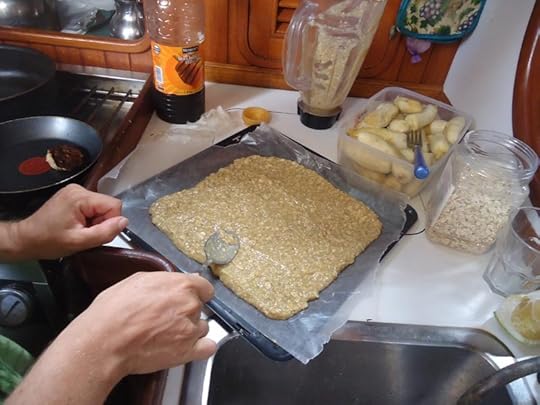
INGREDIENTS:
10-15 very ripe bananas
2 or 3 cups of oats
2 limes (juice+zest)
honey and cinnamon to taste
1 cup of sesame seeds
different types of dried fruit (sultanas, mangoes, papayas…) cut in small pieces
NOTE: This is just one example. But there are infinite other options, depending on your taste and what you happen to have in the galley at the time. Be creative!
Mix well (I use the blender, but if you don’t have one aboard, just mix very well by hand)
Cover a tray* with a sheet of grease-proof paper
Pour some of the mix on the tray and spread it evenly with the back of a spoon, about 4mm thick.
Put the tray somewhere on deck, where there is plenty of sunshine.
After several hours under the tropical sun, the mix should be dry enough to be turned over using two trays. (If the sun is not very strong and there is no wind, you may have to wait until the next day, but remember to store it down below overnight.)
After you turn the mix over, gently peel off the paper.
When dry enough, cut the mix into bars and let them dry a bit longer.
One day or two of drying should be enough if you plan to eat the fruit bars soon, but if you want to keep them longer, there should be absolutely no moisture trapped inside them.
The result should look more ore less like this:
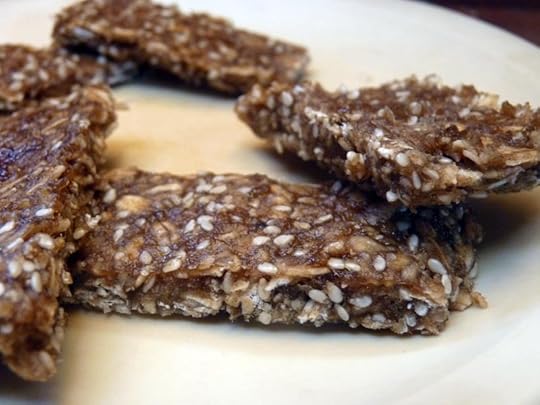
BON APETTIT!
* I use the trays from the dryer, which are perforated and therefore allow plenty of airflow under the mix. If you use normal trays, you may have to turn the bars over more often to dry both sides evenly.
August 18, 2015
Calling a Spade, a Spade
If you have read our book you will know how we feel about spade (unsupported) rudders. We don’t like them and consider them a pretty bad idea for a voyaging boat. For those that haven’t read the book, a properly supported rudder is an essential facet of a voyaging boat. A spade rudder simply hangs down from the hull on a stainless steel shaft. This make them fantastically vulnerable to damage from collision with sea debris (floating logs, half submerged containers, dozing mermaids, etc.) and we go to great pains in our book to discourage all potential sea gypsies from buying this type of boat. (See picture).
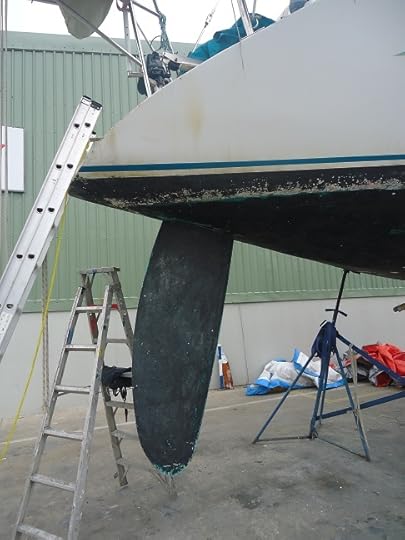
A typical spade rudder
Something we did not go into (and probably will in the next edition) is the added risk of “work hardening” on spade rudder shafts. We have all experienced work hardening in other areas of our lives. This is the process that allows us to break certain materials by repeated bending. Take a paper clip and straighten it out. Now bend it backwards and forwards. Pretty soon the paper clip will break at the point where you have been bending it. This is not because it has got softer, but because the point where all the “work” was being done actually got harder, and therefore more brittle and no longer able to bend as efficiently.
As is often the case in so many areas of life – that which cannot bend, breaks.
All rudders have to absorb large forces from the sea. That is a given. The problem the spade rudder has (being unsupported at the bottom) is that each time a wave rolls across it, the shaft flexes from one side to the other – just like the paper clip in the experiment – with the point doing the most work being where the shaft of the rudder exits the hull. Can you guess what happens?
You got it – work hardening at that point. Then failure.
Funnily enough, I was just explaining this very process to a potential sea gypsy who contacted us after reading our book, when we heard that a boat had been towed into the local yard with rudder problems (we are currently in Fiji).
Being fantastically nosey about this kind of thing, I dashed over (all of 500 meters) to find out what had happened. I think the pictures tell the story (see below).
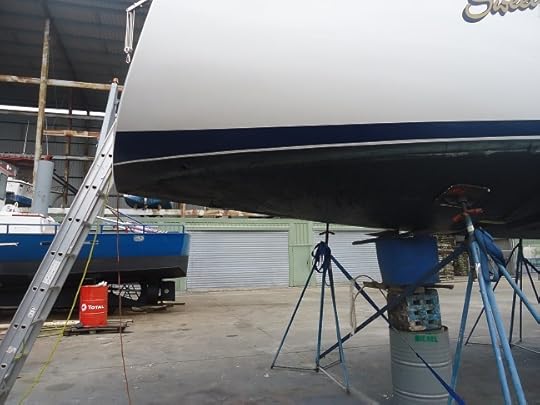
Spade Rudder sheared off.
As you can see in the first picture, the rudder has gone. The whole thing is now resting in the silt 5 kilometres under the surface of the Pacific Ocean and will cost several thousand dollars to replace.
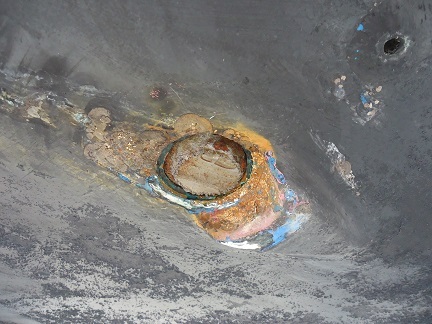
The shaft has sheared off
In the next picture, you can see that the shaft has snapped at precisely the place the principal of work hardening would predict.
This poor sailor is also facing a bill of $7000 for the tow into Fiji, and a couple of thousand for the boatyard. Had he been further offshore, the tow could have cost several times that. If he had been offshore in bad weather, the cost may not have been calculable in dollars.
Spade rudders are cheap to produce and fit. Manufacturers tell us that they are also a good idea and produce all kinds of spurious figures and twisted logic to convince us that what they want to sell us is what we want to buy.
Regardless of what the salesmen and racing crowd say, there is no possible way a spade rudder is stronger than a supported rudder. The numbers simply don’t add up any better than the numbers for building a house without foundations. Find me a qualified engineer that will say any different in writing and I will show you someone who is working for the yachting industry.
But while uninformed sailors continue to buy spade-ruddered boats for their marble counter tops and en-suite bathrooms, this is what the manufacturers will continue to produce. And who can blame them? They have to sell boats in a very competitive environment and new sailors don’t give a hoot about the rudder.
It is up to us to demand sea-worthiness in yacht design by rejecting unsound practices – no matter how nice the cockpit cushions are or how large the aft cabin is.
Rejecting spade rudders is a good place to start.
Fair Winds,
Rick and Jasna
PS Has anyone else got any spade rudder horror stories? We would like to hear them -especially if you have photos.
August 8, 2015
We are on the telly!!!
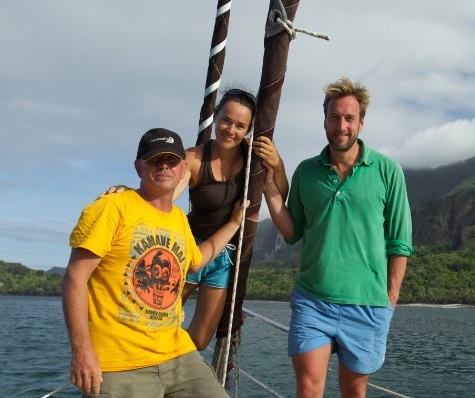
Dear Friends.
If you can stand our faces for almost one hour, than check out Ben Fogle’s tv program New Lives in the Wild
on Channel 5 on August 10th at 9pm (London time).
If you miss it, you can see it later on their website www.channel5.com
Below you can find some news about us in the English media:
TalkTalk: Ben heads to French Polynesia in the South Pacific to spend time with British expat Rick and his girlfriend Jasna, who live a nomadic life on their yacht, sailing around the waters of the archipelago they have made their home. Ben builds hammocks, rigs sails, spears fish for dinner, freedives to drop anchor, experiences rough seas and learns how the couple use the islands to support their transient lifestyle, washing clothes in rivers and shopping for essentials by kayak
Whatsontv: Lucky Ben ends this run in French Polynesia to meet Londoner Rick, who lives on a 36ft boat sailing the Pacific with girlfriend Jasna. The scenery is just stunning and the ocean-loving couple are the picture of contentment. Both say they were born with itchy feet and live for the moment, sailing around beautiful islands and doing a bit of work where they can to buy the barest of essentials. Ben tries to find a few hardships in their idyllic life, but Rick and Jasna were meant to live exactly as they are – footloose and fancy free on the ocean waves.
Click HERE to see the trailer.
cheers,
Rick and Jasna
July 22, 2015
Our book is now available!
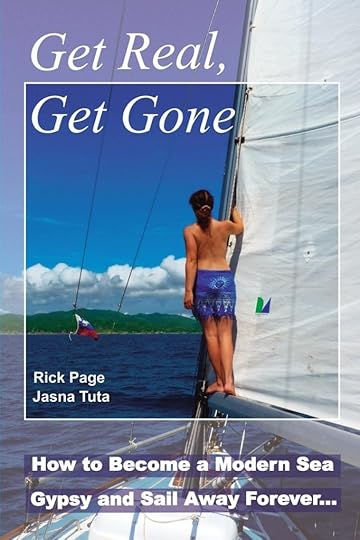
Our recent appearance on Ben Fogle’s New Lives in the Wild introduced the idea of budget sailing to a whole new audience – an audience who may have never considered the possibility that such a dream could be made a reality, on such a small amount of money. This book is for them and for any experienced sailors who want to cast off the yoke of consumerist yachting and get back to what really matters at sea.
You can buy our ebook in the following online bookshops:
Amazon.com, Amazon.co.uk, Amazon.it, iBooks, Nook, kobo and Oyster.
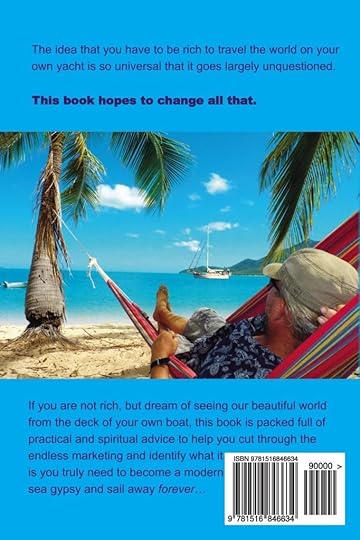 The paperback is now available as well, you can buy it on:
The paperback is now available as well, you can buy it on:
*Create Space: Get Real, Get Gone: How To Become a Modern Sea Gypsy and Sail Away Forever
*Amazon.co.uk: Get Real, Get Gone: How to Become a Modern Sea Gypsy and Sail Away Forever
*Amazon.com: Get Real, Get Gone: How to Become a Modern Sea Gypsy and Sail Away Forever
*Amazon.it: Get Real, Get Gone: How to Become a Modern Sea Gypsy and Sail Away Forever
June 9, 2015
Sailing over lemons
Before I became a wandering sea gypsy, I owned a farm in the Alpujarra Mountains in Southern Spain where I trained Andalucian horses.
 Shortly after I bought the place, Chris Stewart the former drummer of the rock group Genesis, published a book about life in the Alpujarra. Unbeknownst to me, he had given up the life of a professional musician and settled in a sleepy town in the Alpujarra mountains to become a sheep farmer and journeyman shearer. His book is called Driving Over Lemons and is actually quite a good read. It sold like crystal-meth and put the Alpujarra Mountains firmly on the mental landscape of the largely British audience who bought it. The Brits seemed to identify with the idea of giving up the madness of life in the UK for a simpler existence amongst the good people of the Alpujarra, and quite a few of them arrived looking for their own mountain escape. What was less apparent in the book was that Mr Stewart’s farm was not actually in the mountains at all, but at the base of the mountains near a town called Orgiva (the biggest town in the region).
Shortly after I bought the place, Chris Stewart the former drummer of the rock group Genesis, published a book about life in the Alpujarra. Unbeknownst to me, he had given up the life of a professional musician and settled in a sleepy town in the Alpujarra mountains to become a sheep farmer and journeyman shearer. His book is called Driving Over Lemons and is actually quite a good read. It sold like crystal-meth and put the Alpujarra Mountains firmly on the mental landscape of the largely British audience who bought it. The Brits seemed to identify with the idea of giving up the madness of life in the UK for a simpler existence amongst the good people of the Alpujarra, and quite a few of them arrived looking for their own mountain escape. What was less apparent in the book was that Mr Stewart’s farm was not actually in the mountains at all, but at the base of the mountains near a town called Orgiva (the biggest town in the region).
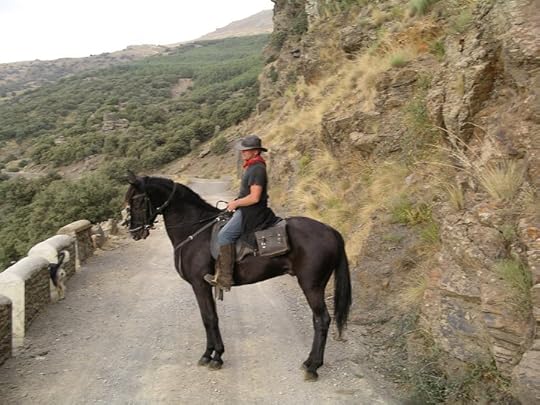 Nevertheless, armed with the proceeds from their expensive flats in Notting Hill, the Brits arrived in the mountains and started buying up the little mountain farms that had been long abandoned. Prices went up and the land began to be cared for again. All well and good. The only problem is that lemons don’t grow in the mountains because it is not hot enough. They grow well enough where Chris Stewart had his farm, but his farm is almost at sea level, despite the impression given by the book. Yet lemons were what the new arrivals had fixated upon and that is what they must have. So, many new arrivals planted lemons and oranges and grapes. Nothing grew of course. A total waste of time, hard work and money (one guy even tried to plant palm trees at 2000 feet above sea level because that is what he associated with luxury). Some new farmers gave up, all were a little disillusioned.
Nevertheless, armed with the proceeds from their expensive flats in Notting Hill, the Brits arrived in the mountains and started buying up the little mountain farms that had been long abandoned. Prices went up and the land began to be cared for again. All well and good. The only problem is that lemons don’t grow in the mountains because it is not hot enough. They grow well enough where Chris Stewart had his farm, but his farm is almost at sea level, despite the impression given by the book. Yet lemons were what the new arrivals had fixated upon and that is what they must have. So, many new arrivals planted lemons and oranges and grapes. Nothing grew of course. A total waste of time, hard work and money (one guy even tried to plant palm trees at 2000 feet above sea level because that is what he associated with luxury). Some new farmers gave up, all were a little disillusioned.
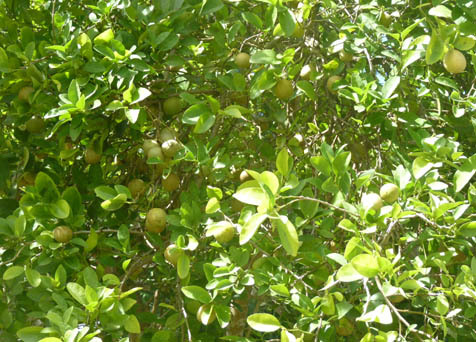 What has all this got to do with sailing? Well, quite a lot actually because much the same pattern occurs amongst new sailors. Bombarded by images of rich men lying on shiny white yachts, surrounded by bikinis and interesting cocktails, it is not surprising that even the most level-headed person comes to suspect that pampered luxury is at least partially the point of life at sea. Many believe it to be the only point. So off they go, trying to make their boat like a little luxury apartment – big cabins with large windows, watermakers, generators, fast dinghies, air conditioning, washing machines, ice-makers, electric winches and all the paraphernalia it takes to run and repair them in the belief that this will bring them happiness. They are of course, amply assisted in developing this view by the companies that profit from the sale of such things.
What has all this got to do with sailing? Well, quite a lot actually because much the same pattern occurs amongst new sailors. Bombarded by images of rich men lying on shiny white yachts, surrounded by bikinis and interesting cocktails, it is not surprising that even the most level-headed person comes to suspect that pampered luxury is at least partially the point of life at sea. Many believe it to be the only point. So off they go, trying to make their boat like a little luxury apartment – big cabins with large windows, watermakers, generators, fast dinghies, air conditioning, washing machines, ice-makers, electric winches and all the paraphernalia it takes to run and repair them in the belief that this will bring them happiness. They are of course, amply assisted in developing this view by the companies that profit from the sale of such things.
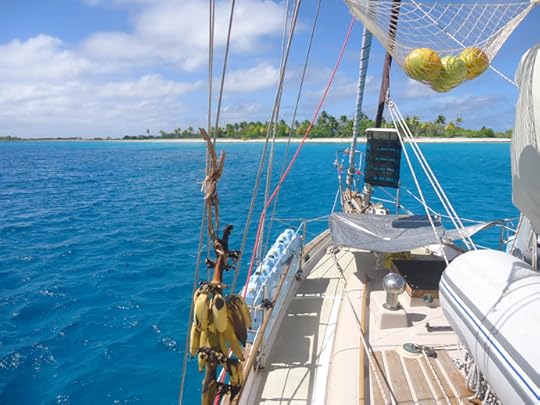 If you have never owned a boat, it is important to understand that despite being several times more expensive than their domestic equivalent, things on boats break down about a hundred times as often as on land, due to the shaking around they get and the constant exposure to salt. If you buy a freezer for your home, you can pretty much plug it in and forget it for the rest of your life. Not on a boat. Not only will it break down way earlier than even a pessimist would expect, it will cost five times as much to repair and involve a lot of mucking about importing parts, employing costly, ’marine’ technicians (whose only qualification over a normal technician is often that he is prepared to come to your boat). Now multiply this headache by all the complicated things on your boat and you will soon be spending all your time working on it (or paying someone else to), chasing down spare parts, fighting with corrupt customs officials (or paying whatever they ask) and pretty soon, you will become totally stressed with the whole thing or be back at work earning money to pay your bills and repeating the obligatory mantra of the terminally disillusioned, “you have to be rich to own a yacht”
If you have never owned a boat, it is important to understand that despite being several times more expensive than their domestic equivalent, things on boats break down about a hundred times as often as on land, due to the shaking around they get and the constant exposure to salt. If you buy a freezer for your home, you can pretty much plug it in and forget it for the rest of your life. Not on a boat. Not only will it break down way earlier than even a pessimist would expect, it will cost five times as much to repair and involve a lot of mucking about importing parts, employing costly, ’marine’ technicians (whose only qualification over a normal technician is often that he is prepared to come to your boat). Now multiply this headache by all the complicated things on your boat and you will soon be spending all your time working on it (or paying someone else to), chasing down spare parts, fighting with corrupt customs officials (or paying whatever they ask) and pretty soon, you will become totally stressed with the whole thing or be back at work earning money to pay your bills and repeating the obligatory mantra of the terminally disillusioned, “you have to be rich to own a yacht”
So, what is the answer?
You guessed it. Raspberries!
Raspberries are a fruit that have certain demands if they are to grow to be nice and sweet. They need a certain type of soil, they like a bit of frost in the mornings and need quite a bit of water. In other words, they are particularly suited to life in the Alpujarra mountains because we have more water than we can use (being the first stop for the melting snow of the Sierra Nevada), we have the occasional frosty morning and the right kind of soil. Furthermore, as Spain is generally quite dry, the few places that can grow raspberries can also command a decent price for them.
By looking around at what the local people were growing and perhaps more importantly, what they were not, many Brits who came to the Alpujarra in the wake of Driving Over Lemons could have avoided a lot of hardship, wastage and disillusionment. By observing reality and reacting to it, rather than trying to strenuously bend reality to fit their fantasies, a negative experience of struggle could have become a positive and rewarding one. Many Brits returned to the UK saying that farming in the Alpujarra was impossible or too difficult, too steep, too cold, or any kind of external explanation. The real culprit of course, as in so many things, was the human mind and its inability to detach itself from its own fixations. We believe that the image in our mind is the one we must ‘achieve’. Encouraged by corporate ideology and western management training ethos, we set our ‘goals’ and must now doggedly pursue them whatever the cost to be ‘successful’ and massage our egos.
Now, I have grown lemons and I have grown raspberries and there is really very little difference between the two – they are both rewarding to grow and the same lifestyle can be achieved by growing either if the conditions are right. There is absolutely no point in forcing the issue and stamping your feet like a petulant child because you can’t have lemons if the conditions are not right for them. Ignore that voice in your head – it is only the rather laughable belief that `you can do anything if you put your mind to it’ that is constantly repeated by inane marketing executives and Nike commercials.
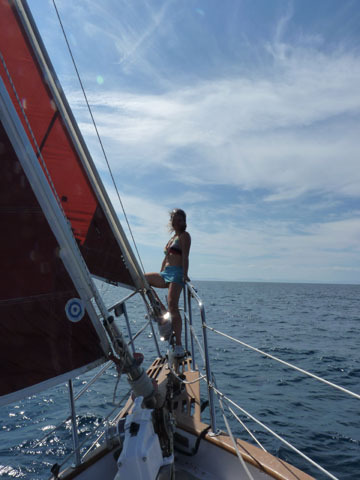 The same goes for sailing. Unhappy will be the sailor who tries to manipulate the reality of the sea to fit the image in his mind. If you can ditch the idea that you simply must have a floating apartment with all the toys of home, the joy of the sailing life will be yours. Ignore this advice and you will be constantly paying, fitting, repairing – paying, fitting, repairing. And if you work really hard, you may have one great moment when nothing needs fixing and you sit down, satisfied. One small, island of peace before something else breaks down and the whole nasty cycle starts up again.
The same goes for sailing. Unhappy will be the sailor who tries to manipulate the reality of the sea to fit the image in his mind. If you can ditch the idea that you simply must have a floating apartment with all the toys of home, the joy of the sailing life will be yours. Ignore this advice and you will be constantly paying, fitting, repairing – paying, fitting, repairing. And if you work really hard, you may have one great moment when nothing needs fixing and you sit down, satisfied. One small, island of peace before something else breaks down and the whole nasty cycle starts up again.
Forget growing lemons simply because that is the image you have had planted in your mind and look what reality is trying to communicate to you. Divest yourself of the idea that pampered luxury is your goal or even desirable. Get rid of all the stupid, complicated devices that eat your time and consume your cash and your soul. Learn to live simply and you will receive all the gifts that the sailing lifestyle is holding in its outstretched hands.
